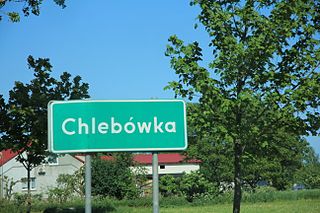| Tragamin | |
|---|---|
| Village | |
 | |
| Coordinates: 54°4′41″N19°2′39″E / 54.07806°N 19.04417°E | |
| Country | |
| Voivodeship | Pomeranian |
| County | Malbork |
| Gmina | Gmina Malbork |
| Population | 501 |
Tragamin [traˈɡamin] (German : Tragheim) is a village in the administrative district of Gmina Malbork, within Malbork County, Pomeranian Voivodeship, in northern Poland. [1] It lies approximately 6 kilometres (4 mi) north of Malbork and 42 km (26 mi) south-east of the regional capital Gdańsk.

German is a West Germanic language that is mainly spoken in Central Europe. It is the most widely spoken and official or co-official language in Germany, Austria, Switzerland, South Tyrol (Italy), the German-speaking Community of Belgium, and Liechtenstein. It is also one of the three official languages of Luxembourg and a co-official language in the Opole Voivodeship in Poland. The languages which are most similar to German are the other members of the West Germanic language branch: Afrikaans, Dutch, English, the Frisian languages, Low German/Low Saxon, Luxembourgish, and Yiddish. There are also strong similarities in vocabulary with Danish, Norwegian and Swedish, although those belong to the North Germanic group. German is the second most widely spoken Germanic language, after English.

A village is a clustered human settlement or community, larger than a hamlet but smaller than a town, with a population ranging from a few hundred to a few thousand. Though villages are often located in rural areas, the term urban village is also applied to certain urban neighborhoods. Villages are normally permanent, with fixed dwellings; however, transient villages can occur. Further, the dwellings of a village are fairly close to one another, not scattered broadly over the landscape, as a dispersed settlement.
Gmina Malbork is a rural gmina in Malbork County, Pomeranian Voivodeship, in northern Poland. Its seat is in the town of Malbork, although the town is not part of the territory of the gmina. Malbork is also the administrative seat or capital of Malbork County.
Before 1772 the area was part of Kingdom of Poland, 1772-1919 Prussia and Germany, 1920-1939 Free City of Danzig, 1939 - February 1945 Nazi Germany. For the history of the region, see History of Pomerania . The village has a population of 501.

The First Partition of Poland took place in 1772 as the first of three partitions that ended the existence of the Polish–Lithuanian Commonwealth by 1795. Growth in the Russian Empire's power, threatening the Kingdom of Prussia and the Habsburg Monarchy, was the primary motive behind this first partition. Frederick the Great engineered the partition to prevent Austria, jealous of Russian successes against the Ottoman Empire, from going to war. The weakened Commonwealth's land, including what was already controlled by Russia, was apportioned among its more powerful neighbors—Austria, Russia and Prussia—so as to restore the regional balance of power in Central Europe among those three countries. With Poland unable to effectively defend itself, and with foreign troops already inside the country, the Polish parliament (Sejm) ratified the partition in 1773 during the Partition Sejm convened by the three powers.

The Crown of the Kingdom of Poland, commonly known as the Polish Crown, or, simply, the Crown, is the common name for the historic Late Middle Ages territorial possessions of the King of Poland, including Poland proper. The Polish Crown was at the helm of the Polish–Lithuanian Commonwealth from 1569 to 1795.

The Free City of Danzig was a semi-autonomous city-state that existed between 1920 and 1939, consisting of the Baltic Sea port of Danzig and nearly 200 towns and villages in the surrounding areas. It was created on 15 November 1920 in accordance with the terms of Article 100 of the 1919 Treaty of Versailles after the end of World War I.






